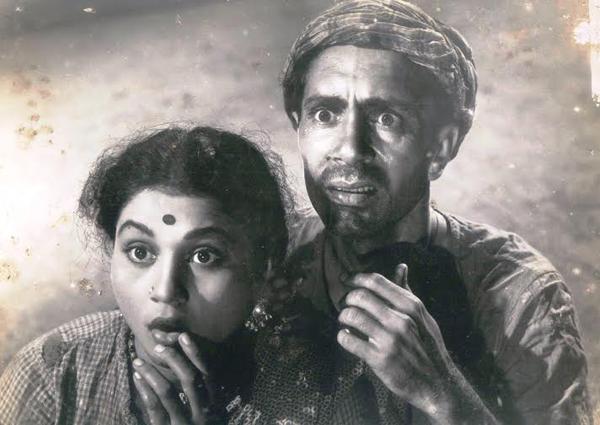 nil
nil
Films in time capsule
India is the largest producer of films in the world but many classics that are milestones in the history of Indian cinema are in danger of extinction. The newly established Film Heritage Foundation in Mumbai strives to reverse the trend. Shoma A. Chatterji reports
.jpg) Films are not only entertainers but also have archival and historical value. Hence when a print is lost to oblivion, something of that history is lost too. That is why today there are efforts to restore and preserve old print by those dedicated to films . The foremost among them is the World Cinema Foundation set up by internationally renowned director Martin Scorsese. “He stopped making films altogether to concentrate on the restoration of old, damaged and lost film prints. Different organizations across the world are contributing to this movement,” informs well-known filmmaker Mrinal Sen. He was specially invited to attend the screening of a restored version of his Khandhar in 2010.
Films are not only entertainers but also have archival and historical value. Hence when a print is lost to oblivion, something of that history is lost too. That is why today there are efforts to restore and preserve old print by those dedicated to films . The foremost among them is the World Cinema Foundation set up by internationally renowned director Martin Scorsese. “He stopped making films altogether to concentrate on the restoration of old, damaged and lost film prints. Different organizations across the world are contributing to this movement,” informs well-known filmmaker Mrinal Sen. He was specially invited to attend the screening of a restored version of his Khandhar in 2010.
This movement has caught on in India with the establishment of the Film Heritage Foundation, a non-profit organization, in Mumbai last year. The brain behind is FTII alumnus Shivendra Singh Dungarpur whose documentary, The Celluloid Man, on film archivist P.K.Nair caught international attention. He is a patron of the British Film Institute and a donor for the restoration of Hitchcock’s silent classic The Lodger. He also facilitated the restoration of the Indian classic Uday Shankar’s Kalpana (1948), done by World Cinema Foundation. It premiered in the Cannes film Festival’s Classic section in 2012.
.jpg) “The idea for the foundation was born because I realised the need to preserve India’s cinematic heritage, severely neglected for years. We have lost a significant part of our cinematic history and this will continue to happen if we don’t take immediate steps to save this legacy,” says Dungarpur . The foundation is dedicated to supporting the conservation, preservation and restoration of the moving image and to develop interdisciplinary educational programmes that will use films as an educational tool to create awareness about the language of cinema.
“The idea for the foundation was born because I realised the need to preserve India’s cinematic heritage, severely neglected for years. We have lost a significant part of our cinematic history and this will continue to happen if we don’t take immediate steps to save this legacy,” says Dungarpur . The foundation is dedicated to supporting the conservation, preservation and restoration of the moving image and to develop interdisciplinary educational programmes that will use films as an educational tool to create awareness about the language of cinema.
The Film Preservation and Restoration School starts functioning by the end of February with the screening of archival films at Liberty Cinema, Mumbai.
As one of the first initiatives, the foundation curated a package of Indian films and newsreels entitled The Golden ‘50s: India’s Endangered Classics screened at Il Cinema Ritrovato festival in Bologna, Italy, in 2014 in collaboration with the National Film Archive of India (NFAI) and the Films Division. The idea was to showcase India’s unique cinematic heritage and to create awareness about the urgent need for its preservation and restoration..jpg)
Il Cinema Ritrovato is an institution unto itself dedicated entirely to preservation and restoration of film classics. The festival takes place in one of Italy’s most beautiful cities, Bologna, home of the world’s oldest university (established in 1088). The festival screens silent films, and displays a very high level of film-historical and film-theoretical energy, both in its programming and in the critics, historians, and theorists invited to speak.
Besides eight newsreels from the FD Archive also showcased were vignettes of history like the meeting of Gandhi and Chaplin, and Mountbatten’s last day as Viceroy of India. Among Indian classics screened were – Chandralekha (1948), Raj Kapoor’s Awara (1951), Bimal Roy’s Do Bigha Zamin (1953), Guru Dutt’s Pyaasa (1957), Mehboob’s Mother India (1957), Ritwik Ghatak’s Ajantrik (1957), Bimal Roy’s Madhumati (1957) and Guru Dutt’s Kaagaz Ke Phool (1959). This was the 28th edition of Ill Cinema Ritrovito Festival dedicated to film restoration and film history.
Restoring a film means finding a copy of the film that is as clean, sharp and clear as possible. Although the film’s original negative is the ideal source from which to begin the restoration, more often than not they are either not available or in such poor condition that they cannot be used any more. This is because commercial films were shot on nitrate film stock before the early 1950s which is highly flammable and often decomposes quickly if not stored properly. Moreover, early film negatives were often discarded by production companies after the film had gone through the distribution cycle, since it was felt there was no longer a market for them. The acetate "safety film" used from the early 1950s until recently has also been found to be unstable, and it has a tendency to fade rapidly.
As a rule of thumb, the more generations the chosen film source is from the camera negative, the grainier the image on that film source will appear. This grain causes the film’s image to lose sharpness and clarity. A ‘positive print’ can only be made from a ‘negative print’, and a negative print can only be made from a positive print. Every time a film print is duplicated from a negative print to a positive print, or vice versa, it loses some of its quality.
Dungarpur travels all over the world to meet and interview on camera great masters of cinema for his personal archive. He has spent time with Manoel de Oliveira in Porto and shot documentaries on Jiri Menzel and Raoul Coutard. He has also shot in-depth interviews with Andrzej Wajda and Krzysztof Zanussi in Warsaw, Miklós Jancsó and István Szabó in Budapest and VÄ›ra Chytilová, Juraj Herz and Jan Nemec in Prague.
“Films are a part of our cultural history. I was shocked to discover that of the 1700 silent films were made in India of which only nine survive thanks to the efforts of Nair. He travelled to remote parts of India to collect and save cans of rare films. The fact that Dadasaheb Phalke is recognized today as the father of Indian cinema is Nair’s doing. He was truly democratic as an archivist trying to save any film that he could get his hands on be it world cinema, Hindi popular films or regional Indian cinema. He even took world cinema to the villages of India,” salutes Dungarpur .
Top Headlines
-
Entertainment
Valentyn Vasyanovychs To The Victory! wins 2025 TIFF Platform Award unanimously
September 26, 2025
-
Entertainment
Chlo Zhaos Hamnet Wins TIFF 2025 Peoples Choice Award
September 20, 2025
-
Entertainment
Sholay: Golden even after fifty years
July 04, 2025
-
Entertainment
War 2: Check out Hrithik Roshan, Jr NTR and Kiara Advani's new posters
June 26, 2025
-
Entertainment
LGBTQIA+: Icelandic film Odd Fish and Brazil's Baby win big at KASHISH 2025 film festival
June 12, 2025
-
Entertainment
Katrina Kaif named Maldives tourism global brand ambassador ahead of Modi's visit
June 10, 2025
-
Entertainment
'Queen marches to conquer': Deepika Padukone joins Atlee's AA22xA6 starring Allu Arjun after 'Spirit' exit
June 08, 2025
-
Entertainment
Dakota Johnson and Chris Martin, who were in on-and-off relationship, broke up: Reports
June 06, 2025
-
Entertainment
Sharmila Tagore to Alia Bhatt, India weaves cross-generational tale at Cannes 2025
May 28, 2025
-
Entertainment
Is Sandeep Reddy Vanga's cryptic 'feminism' post meant for Deepika Padukone? Neitzens think so
May 27, 2025


